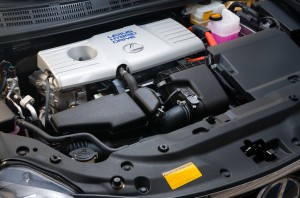
Americans are opting for smaller and smaller engines - with or without hybrid technology, like this four-cylinder package in the Lexus CT 200h.
American motorists have proven decidedly stubborn when it comes to downsizing, willing to hang onto their pickups, SUVs and bigger passenger cars despite near-record fuel prices.
But buyers are showing a lot more flexibility with what they order under the hood. Makers like Ford are scoring big gains with smaller powertrains, such as the EcoBoost V6 offered on the latest version of the F-Series pickup.
In fact, the trend towards smaller engines has not only swept aside the V8 but now threatens to marginalize the V6. With a number of new models, such as the latest Hyundai Sonata, not even offering six-cylinder options, the Inline-4, or I-4, engine became the most popular powertrain choice among U.S. consumers during the first half of 2011, according to research firm IHS Automotive.
Four-cylinder engines now account for 43% of the U.S. automotive market, up from 26% in 2005. During the same time period, the six-banger dropped from 43% to just 37%. And the once all-mighty V-8, that simple of American muscle? It has dipped from 29% to just 18% over the past six years, with most studies predicting still further declines.
Fuel prices have been a critical motivator, according to both IHS and industry planners. At $4 a gallon, it becomes much more difficult to justify big sixes and eights, especially as the latest powertrain technology just keeps getting better and better.
“We’re doing things we didn’t think possible a decade ago,” with such technologies as direct injection, and turbocharging, noted Larry Dominique, product czar at Nissan.
Ford contends it can deliver V-8 performance with a six-cylinder Ecoboost, but will downsize even more with a 1.0-liter, three-cylinder version under development. Chrysler is readying both eight and nine-speed gearboxes that will improve both performance and mileage as it also downsizes engine offerings.
Makers were already under pressure to develop such fuel-saving technologies to meet the 2016 Corporate Average Fuel Economy standard, which pushes to 37.5 mpg. Further powertrain downsizing – and possibly the use of electric propulsion systems – will be critical if the government approves the 56.2 mpg CAFE standard now under debate.
In many cases, motorists are opting for smaller powertrains where available. The V-6 option is now the hot package on the Ford F-150. But in other cases, makers are simply eliminating larger engine offerings. Hyundai and Korean sibling Kia, for example, no longer offer V-6s on their midsize Sonata and Optima models.
How much further will the trend continue? The 3-cylinder Ford EcoBoost could be a critical test. Right now, 4s, 6s and 8s account for 98% of the American automotive market. Big 12-cylinder luxury engines, pure battery-electric, hydrogen fuel cell and other internal combustion layouts make up the remaining 2%.
The smallest engines appear to have the most to gain. And it’s not just the number of cylinders being downsized, according to a report in Automotive News. The trade publication quotes a report by Continental, the German mega-supplier, which anticipates the percentage of engines that are smaller than two liters will double by late in the decade.
Today, such pint-sized powertrains make up barely a tenth of the U.S. market. Continental expects that to reach 20% — a total of 3.4 million vehicles a year – by 2017.

“How much further will the trend continue? The 3-cylinder Ford EcoBoost could be a critical test.”
The trend will continue below the three cylinders.
The Fiat 500 TwinAir engine, voted by 70 car-journalists as “by far the best engine of the year 2011” at Engine-Expo Stuttgart Germany, has only two cylinders.
According the voters-journalists: this twin cylinder engine combines the power and feeling of a four cylinder with way better fuel efficiency.
The two-cylinder OPOC engine of Ecomotors is also a well-known case.
On the other hand, if a single-cylinder engine could provide the vibration-free quality of a V-8 or of a V-12, the trend of engine downsizing will, reasonably, continue even below the two cylinders.
Take a look at the simple, full-balanced, single-cylinder OPRE, PatOP and PatPOC engines at http://www.pattakon.com
Thanks
Manousos Pattakos
Interesting, Manousos. Just think, more than a century after the original Benz returning to a single-cylinder engine design…?
Paul A. Eisenstein
Publisher, TheDetroitBureau.com
Excluding the snobbery, is there a good reason for not using “a single-cylinder engine design” in a car?
In case the two-cylinder engine of the Fiat 500 TwinAir is as good as the auto-journalists write and vote, the single-cylinder PatOP direct injection Diesel is the reasonable next step.
Think:
Both, the two-cylinder Fiat TwinAir and the single-cylinder PatOP, have one power pulse (one combustion) per crank rotation.
Think also:
The Fiat TwinAir has one counterbalancing shaft, while the PatOP has none.
Despite its counterbalancing shaft (weight, friction), the Fiat TwinAir still has significant unbalanced inertia forces that cause vibrations and noise, while the inertia forces of the single-cylinder opposed-piston PatOP are perfectly balanced.
Things are quite simple:
If the TwinAir of Fiat fits to medium / small cars, the single cylinder PatOP ( http://www.pattakon.com/pattakonPatOP.htm ) fits better.
Thanks
Manousos Pattakos